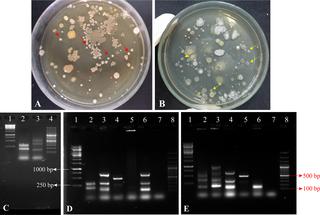PLOS ONE ( IF 2.9 ) Pub Date : 2018-09-21 , DOI: 10.1371/journal.pone.0204408 Muhammad Suleman 1 , Sumera Yasmin 1 , Maria Rasul 1 , Mahreen Yahya 1 , Babar Manzoor Atta 2 , Muhammad Sajjad Mirza 1

|
The aim of this study was to isolate, characterize and use phosphate solubilizing bacteria to enhance the bioavailability of insoluble Ca-phosphate for wheat plants. For this purpose, 15 phosphorus solubilizing bacteria (PSB) were isolated from wheat rhizospheric soils of Peshawar and southern Punjab region, Pakistan. These isolates were identified using light microscopy and 16S rRNA gene. Among the isolated bacteria, two strains (Pseudomonas sp. MS16 and Enterobacter sp. MS32) were the efficient P solubilizers based on their P solubilization activity determined qualitatively (solubilization index 3.2–5.8) as well as quantitatively (136–280 μg mL-1). These two strains produced indole-3-acetic acid (25.6–28.1 μg mL-1), gibberellic acid (2.5–11.8), solubilized zinc compounds (SI 2.8–3.3) and showed nitrogenase and 1-Aminocyclopropane-1-carboxylic acid deaminase activity in vitro. Phosphate solubilization activity of Pseudomonas sp. MS16 was further validated by amplification, sequencing and phylogenetic analysis of glucose dehydrogenase (gcd) gene (LT908484) responsible for P solubilization. Response Surface Methodology for large-scale production was used to find optimal conditions (Temperature 22.5°C, pH 7) for P solubilization. Glucose was found to support higher P solubilization in vitro. In an in vitro experiment, PSB treated wheat seedlings improved germination and seedling vigor (11% increases) as compared to un-inoculated control. Rhizoscanning of these seedlings showed an increase in various root growth parameters. Wheat inoculation with selected strain MS16 showed pronounced effect on grain yield in pot (38.5% increase) and field (17–18% increase) experiments compared to non-inoculated control. Root colonization by PSB through Florescent in situ Hybridization and Confocal Laser Scanning Microscopy confirmed their rhizosphere competence in soil. BOX-PCR confirmed the re-isolated colonies of Pseudomonas sp. MS16. The results indicated that gluconic acid producing Pseudomonas sp. MS16 from un-explored soils may be cost effective and environment friendly candidate to improve plant growth and phosphorous uptake by wheat plants.
中文翻译:

具有葡萄糖脱氢酶基因的解磷细菌对磷的吸收及其对小麦的有益影响
本研究的目的是分离、表征和使用解磷细菌来提高小麦植物不溶性磷酸钙的生物利用度。为此,从巴基斯坦白沙瓦和旁遮普南部地区的小麦根际土壤中分离出 15 种解磷细菌 (PSB)。使用光学显微镜和 16S rRNA 基因鉴定这些分离株。在分离的细菌中,根据定性(增溶指数 3.2-5.8)和定量(136-280 μg mL -1 )测定的 P 增溶活性,两株菌株(假单胞菌MS16 和肠杆菌MS32)是有效的增磷剂。 )。这两个菌株产生吲哚-3-乙酸 (25.6–28.1 μg mL -1 )、赤霉酸 (2.5–11.8)、溶解的锌化合物 (SI 2.8–3.3),并显示固氮酶和 1-氨基环丙烷-1-羧酸脱氨酶体外活性。假单胞菌的磷酸溶解活性。通过对负责解磷的葡萄糖脱氢酶 ( gcd ) 基因 (LT908484) 进行扩增、测序和系统发育分析,进一步验证了 MS16。采用大规模生产的响应面方法来寻找溶磷的最佳条件(温度 22.5°C,pH 7)。葡萄糖被发现在体外支持更高的磷溶解。在一项体外实验中,与未接种的对照相比,PSB 处理的小麦幼苗提高了发芽率和幼苗活力(增加了 11%)。这些幼苗的根部扫描显示各种根生长参数有所增加。与未接种的对照相比,在盆栽(增加 38.5%)和田间(增加 17-18%)实验中,接种选定菌株 MS16 的小麦对谷物产量有显着影响。PSB 通过荧光原位杂交和共焦激光扫描显微镜进行的根定殖证实了它们在土壤中的根际能力。BOX-PCR 证实了重新分离的假单胞菌菌落。MS16。结果表明,产葡萄糖酸假单胞菌属sp.。来自未开发土壤的 MS16 可能是具有成本效益且环境友好的候选物,可改善植物生长和小麦植株对磷的吸收。











































 京公网安备 11010802027423号
京公网安备 11010802027423号